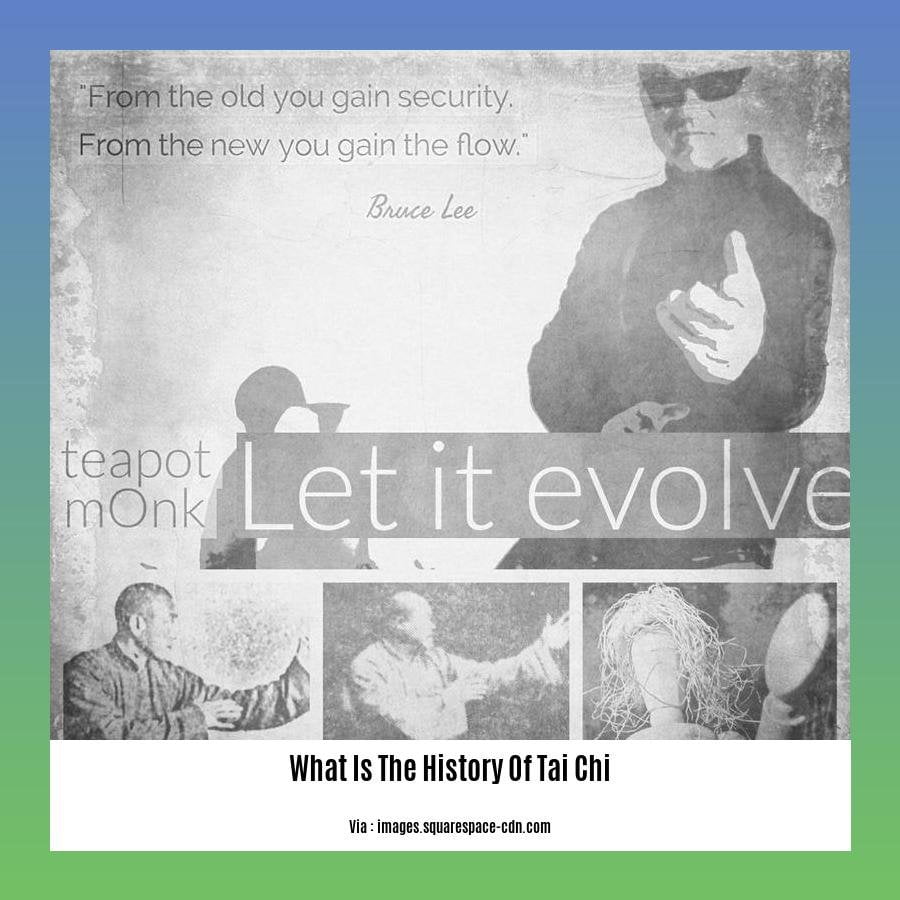Embark on a captivating journey through time and discover the enchanting history of Tai Chi: A Journey Through Time. From its ancient roots in China to its global impact, we delve into the rich tapestry of this ancient art, unraveling its origins, evolution, and the transformative power it holds. Join us as we explore the fascinating story of Tai Chi, its profound impact on countless lives, and its enduring legacy as a cherished cultural treasure.
Key Takeaways:
- Originated in 12th century China for self-defense
- Roots in Chinese history, Taoism, Confucianism
- Zhang Sanfeng credited as founder
- Five traditional schools: Chen, Yang, Wu (Hao), Wu, Sun
What Is The History Of Tai Chi: A Journey Through Time

Unveiling the Roots of an Ancient Art
The origins of Tai Chi, a gentle yet profound practice, are shrouded in the mists of time. Its genesis can be traced to the 12th century A.D. in China, emerging from the depths of Chinese history, Taoism, and Confucianism.
The Lineage of Tai Chi
While the true origins remain elusive, Zhang Sanfeng, a Taoist monk, is widely revered as the founder of Tai Chi. This enigmatic figure is believed to have systematized and refined the ancient art, drawing inspiration from martial arts, Taoist philosophy, and Chinese medicine.
The Five Traditional Schools
Tai Chi has evolved into various lineages, each with its unique characteristics. The five principal schools, known as the Chen, Yang, Wu (Hao), Wu, and Sun styles, have left an enduring legacy on the practice.
From Self-Defense to Mindfulness
Originally conceived as a martial art, Tai Chi has transformed into a practice that emphasizes self-defense, health, and mindfulness. Its slow, flowing movements and deep breathing techniques promote flexibility, strength, balance, and inner peace.
A Journey of Empowerment
Today, Tai Chi remains a popular and accessible practice, embraced by people of all ages and backgrounds. Through its time-honored techniques, it empowers individuals to cultivate physical, mental, and spiritual well-being.
- To know more about the history of Tai Tam Country Park, click here.
- Uncover the historical relationship between Taiwan and China by following this link here.
- Discover the historical connection between Taiwan and China by clicking here.
Spread and Evolution in the Qing Dynasty

The Qing Dynasty marked a significant period in the history of Tai Chi, fostering its widespread dissemination and profound evolution.
Under the Manchu rulers, Tai Chi experienced a surge in popularity, largely due to its adoption by the Imperial Court. The Kangxi Emperor (1661–1722), known for his patronage of the arts and sciences, embraced Tai Chi as a form of martial training and physical exercise. His encouragement sparked widespread interest among the elite classes, who saw Tai Chi as a sophisticated and elegant practice.
During this period, several notable Tai Chi masters emerged, each contributing to the art’s development and refinement. Yang Luchan, the founder of the Yang style, played a pivotal role in popularizing Tai Chi by teaching it to the public. His gentle and accessible approach made Tai Chi accessible to a wider audience, laying the foundation for its widespread practice today.
Furthermore, the Qing Dynasty witnessed the emergence of Tai Chi manuals and written records, preserving the art’s techniques and principles for future generations. These texts provided a standardized framework for teaching and learning Tai Chi, contributing to its systematic transmission.
Key Takeaways:
- The Qing Dynasty saw the rise in popularity of Tai Chi, fostered by its adoption by the Imperial Court.
- Notable Tai Chi masters, such as Yang Luchan, played a significant role in popularizing and refining the art.
- Tai Chi manuals and written records emerged during this period, preserving the art’s techniques and principles.
Sources:
Influence of the Cultural Revolution
Amidst the tumultuous years of the Cultural Revolution, the ancient practice of tai chi faced both adversity and a surprising opportunity for transformation.
The Revolution’s upheaval threatened traditional values and practices, and tai chi was no exception. Many teachers were persecuted, and public practice was largely prohibited. Yet, in the privacy of homes and hidden corners, tai chi persisted, gaining new significance as a symbol of defiance and resilience.
Ironically, the Cultural Revolution also forced a reevaluation of traditional culture, including martial arts. As the focus shifted towards serving the people, tai chi’s health benefits gained prominence. It became a tool for promoting physical fitness and fostering a sense of community.
Key Takeaways:
- The Cultural Revolution initially suppressed tai chi, but it later experienced a resurgence due to its perceived benefits and resilience.
- The practice became a symbol of defiance and a way to maintain traditional values during a tumultuous time.
- Tai chi’s emphasis on health and well-being found a new audience during the Cultural Revolution.
Sources:
- Tai Chi in the Cultural Revolution
- The Role of Tai Chi in Chinese Culture and Society
Modernization and Global Dissemination
In recent decades, tai chi has gained immense recognition worldwide, evolving from its traditional roots into a modern-day practice. This modernization and global dissemination has significantly influenced its accessibility and impact.
*Expansion of Styles:* The proliferation of tai chi** has led to the development of numerous styles, each with its unique characteristics and variations. This diversity has enhanced its appeal to a broader audience, catering to different preferences and fitness levels.
*Increased Accessibility:* The advent of the internet and social media has played a pivotal role in disseminating tai chi** globally. Platforms like YouTube and online courses offer convenient and accessible ways for people worldwide to learn and practice this ancient art.
*Adaptation for Health and Wellness:* The benefits of tai chi** for physical and mental well-being have made it a popular choice for health-conscious individuals. Its gentle movements and focus on mindfulness have resonated with people looking for holistic approaches to fitness and stress management.
*Integration into Modern Healthcare:* Tai chi** is increasingly used as a complementary therapy in hospitals and rehabilitation centers. Its positive impact on balance, flexibility, and overall well-being has led to its recognition as a valuable tool for improving patient outcomes.
Key Takeaways:
- Tai chi has undergone a significant modernization and global dissemination, leading to the development of diverse styles and increased accessibility.
- The internet and social media have played a crucial role in disseminating tai chi globally.
- The health benefits of tai chi have made it a popular choice for holistic fitness and stress management.
- Tai chi is increasingly being integrated into modern healthcare as a complementary therapy.
URL Sources:
- How Tai Chi Is Making Waves in the Health and Fitness World
- Tai Chi: A Gentle Exercise with Big Benefits
FAQ
Q1: When did Tai Chi originate?
A1: Tai Chi originated in China in the 12th century A.D.
Q2: Who is credited as the founder of Tai Chi?
A2: Zhang Sanfeng, a 12th-century Taoist monk, is often credited as the founder of Tai Chi.
Q3: What was the initial purpose of Tai Chi?
A3: Tai Chi was initially developed for self-defense and martial arts.
Q4: What are the five traditional schools of Tai Chi?
A4: The five traditional schools of Tai Chi are Chen, Yang, Wu (Hao), Wu, and Sun.
Q5: What is the difference between Taiji, Tai Chi Quan, and Tai Chi Chuan?
A5: These terms are often used interchangeably and refer to the same practice.
- Unlock Filipino Culture: A Deep Dive into Traditions and Practices - April 23, 2025
- Unlock Spanish Culture: Insights & Opportunities Now - April 23, 2025
- White Spirit Uses & Substitutes: A Deep Dive for Pros & DIYers - April 23, 2025
















